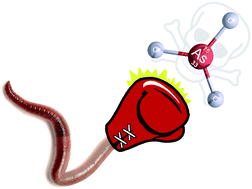Arsenic biotransformation in earthworms from contaminated soils
Abstract
Two species of

* Corresponding authors
a
British Geological Survey, Keyworth, Nottingham, UK
E-mail:
mbutton@bgs.ac.uk, mwatts@bgs.ac.uk
Fax: +44 0115 9363200
Tel: +44 0115 9363100
b
Department of Geology, University of Leicester, Leicester, UK
E-mail:
grtj1@leicester.ac.uk, mb274@le.ac.uk
Fax: +44 0116 2523918
Tel: +44 0116 2523934
c School of Science and Technology, Nottingham Trent University, Nottingham, UK
Two species of

 Please wait while we load your content...
Something went wrong. Try again?
Please wait while we load your content...
Something went wrong. Try again?
M. Button, G. R. T. Jenkin, C. F. Harrington and M. J. Watts, J. Environ. Monit., 2009, 11, 1484 DOI: 10.1039/B904104D
To request permission to reproduce material from this article, please go to the Copyright Clearance Center request page.
If you are an author contributing to an RSC publication, you do not need to request permission provided correct acknowledgement is given.
If you are the author of this article, you do not need to request permission to reproduce figures and diagrams provided correct acknowledgement is given. If you want to reproduce the whole article in a third-party publication (excluding your thesis/dissertation for which permission is not required) please go to the Copyright Clearance Center request page.
Read more about how to correctly acknowledge RSC content.
 Fetching data from CrossRef.
Fetching data from CrossRef.
This may take some time to load.
Loading related content
